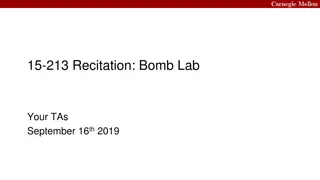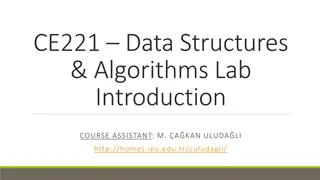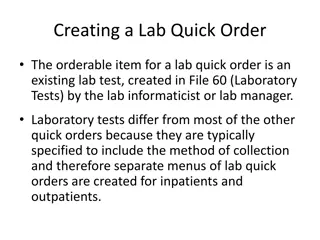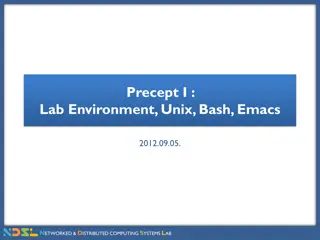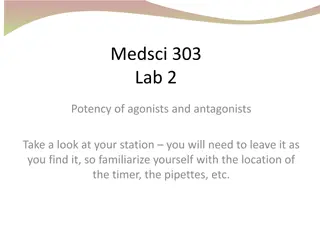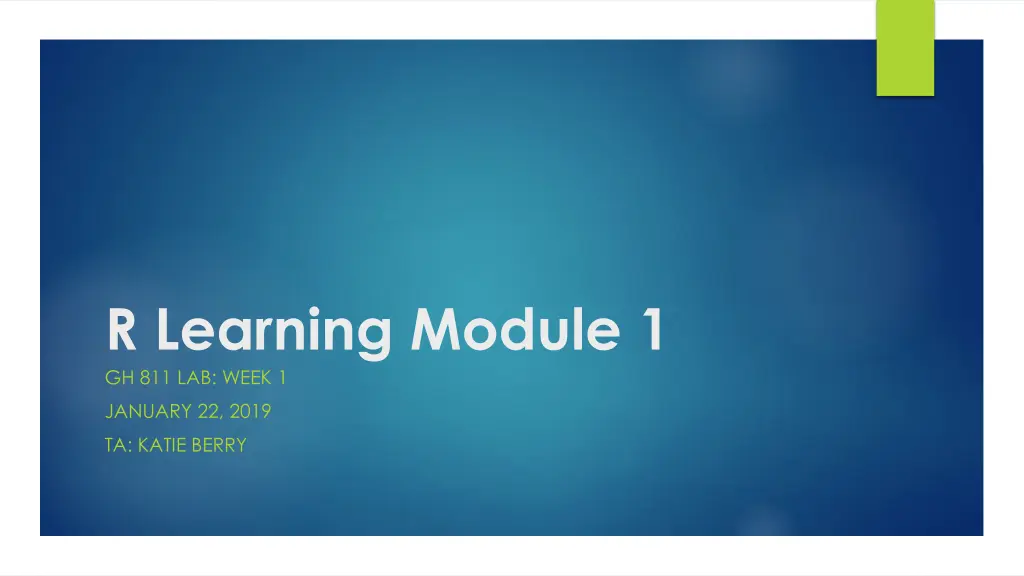
R Studio Interface Overview
Explore the components of the R Studio interface including the workspace, script editor, console, environment, and plot viewer. Learn how to effectively utilize each section for efficient coding and data analysis in R programming.
Download Presentation

Please find below an Image/Link to download the presentation.
The content on the website is provided AS IS for your information and personal use only. It may not be sold, licensed, or shared on other websites without obtaining consent from the author. If you encounter any issues during the download, it is possible that the publisher has removed the file from their server.
You are allowed to download the files provided on this website for personal or commercial use, subject to the condition that they are used lawfully. All files are the property of their respective owners.
The content on the website is provided AS IS for your information and personal use only. It may not be sold, licensed, or shared on other websites without obtaining consent from the author.
E N D
Presentation Transcript
R Learning Module 1 GH 811 LAB: WEEK 1 JANUARY 22, 2019 TA: KATIE BERRY
The R Studio Interface: Workspace/ Environment R Script Plots/ help/ packages R Console
R Script Top left corner Type your code here Typing in the script allows you to save the script, reopen it, and edit it next time To open a new script: File New File R Script Click the first icon that looks like a blank page with a green plus
R Console Bottom left corner This is where R actually processes and executes code Output appears here You can type code here BUT R runs each line as you type it Can t edit command after you hit enter PLEASE ALWAYS WRITE YOUR CODE IN THE SCRIPT FOR THIS CLASS (not in the console)!
R Environment/Workspace Top right corner Includes every object in your current session (data sets, values saved as objects, regression results, etc.) Double click on a data set listed in the workspace to view its contents History tab shows code that you have run through the console in the past (even if you clear the console)
Final Quadrant Bottom right corner View plots you have generated Access help files View packages installed
Using # To Comment Use # before text to write comments to yourself or others within your code At the top of your R script please include: #Name #Date #Info on the assignment Also helpful to include comments on what question you are working on or what you are trying to do #Set directory and read in data #Question 1: You can also use comments to include output from the console in your script #Answer: 5 tells us the result you got after running the code for a particular question
Using # to create a header box #################################### # # # GH811 Lab: Week 1 Notes # # January 22, 2019 # # Katie Berry # # # ####################################
Using # to create sections Enclosing text with #### on each side will allow you to segment your code into sections These sections can be collapsed and expanded Examples: #### Section 1: The Working Directory ##### #### Question 1 ####
The Working Directory Points R to a folder on your computer where it should look to read or write files Do this at the top of every R script To find the path for the folder on a PC: Find the folder you are looking for in File Explorer Right click on a document within that folder and click Properties The path will then appear under Location To find the path for the folder on a Mac Find the folder you are looking for in Finder Right click on the folder Hit the option key and then click copy (this will copy the path/location instead of the actual file)
Step 1 my_folder <- "//ad.bu.edu/bumcfiles/SPH/IH/berrykm1/GH811/Spring 2019/Week 1/Week 1 Lab" This code creates an object called my_folder that stores the location of the folder you want to use You can name the object how you like (ie input instead of my_folder ) Let s say you are working on a project with multiple years of data and you want to keep the files separate: input_y1 <- "C:/Users/kaitl/Documents/Project/Year1" input_y2 <- "C:/Users/kaitl/Documents/Project/Year2" This allows you to create shortcuts to both folders that you can reference later using input_y1 and input_y2 instead of the full file locations Remember to use forward slash (/) instead of backslash(\) when specifying file location!
Step 2 setwd(my_folder) Sets the file folder we named my_folder as our working directory Use the getwd() command to check what you have set as your directory: getwd() ##[1] "//ad.bu.edu/bumcfiles/SPH/IH/berrykm1/GH811/Spring 2019/Week 1/Week 1 Lab" If you want to change to a different folder (like input_y1 or input_y2), you can just set the directory again in a new line of code
Step 3 data <- read.csv("Lab 1 Sample.csv", header=TRUE) This code reads in a .csv file called Lab 1 Sample It also stores the data set in an object called data The name doesn t matter here so call it what you want Note that you don t have to include the full path for the file because it is in our working directory folder (my_folder) and R knows were to find it! Our data set should now appear in our workspace (top right corner) Double click to view head() command will show us the first 6 rows of data so we can verify it looks okay head(data)
##STEP 1: #Create a object named "my_folder" that specifies the path to a folder on my computer my_folder <- "//ad.bu.edu/bumcfiles/SPH/IH/berrykm1/GH811/Spring 2019/Week 1/Week 1 Lab" ##STEP 2: #set the working directory setwd(my_folder) #check to see if you set the working directory correctly getwd() ##STEP 3: #Read in the data from a .csv file data <- read.csv("Lab 1 Sample.csv", header=TRUE) #Verify data was read correctly by calling the first 6 rows of data head(data)
Data Structures in R R has an object-oriented data type system Each type of object has its own properties Major types Scalars Vectors Matrices Lists Data frames Factors
Scalars A scalar is simply an individual numbers Examples: 1 387 15 Let s say we want to store my age in an object: age <- 27 If we want to view this number later, we can simply call the age object and the number will appear in the console when we run the code age Console view [1] 27
Vectors A vector is an array of elements with the same mode (ie numeric, character) Individual variables in a data frame are stored as vectors Examples: 1, 2, 3, 4, 5 biostats, epi, policy, environ Let s say we want to store the colors of the rainbow as a vector rainbow <- c("red", "orange", "yellow", "green", "blue", "indigo", "violet") Storing numbers as a vector x <- c(1,2,3,4,5,6,7,8,9,10) We can then call these objects to view their contents rainbow ## [1] "red" "orange" "yellow" "green" "blue" "indigo" "violet"
Vectors (cont.) Use the is.vector command to check if something is a vector is.vector(rainbow) ## [1] TRUE Note that scalars are stored in R as vectors with a length of 1, so if we ask R about a scalar, it will tell us it is a vector age ## [1] 27 is.vector(age) ## [1] TRUE
Matrices A matrix is a rectangular array of same-length vectors, all of which have the same mode R functions that perform statistical models often require the input to be a matrix Example of a 3x3 matrix:
Matrices (cont). mat_ex <- matrix(c(1,2,3,4), nrow=2, ncol=2) Creates a 2x2 matrix from a vector of 4 numbers Names the matrix mat_ex nrow and ncol specify the number of rows and columns we want Default is to fill by row (ie first row then second row) Call that matrix: mat_ex ## [,1] [,2] ## [1,] 1 3 ## [2,] 2 4 Use is.matrix() command to check if something is a matrix Don t worry too much about understanding matrices for now!
Lists A list is a collection of other objects, none of which has to be of the same mode or structure A list could contain both a character vector and a numeric matrix as separate elements Many R functions that perform statistical models return the same output as a list containing various components Don t worry too much about lists for now!
Data Frames In a data frame, each column is a vector that can be of different modes Data frames are similar to datasets in SAS or Stata Example: Beyonce George Christiano Taylor Knowles-Carter Clooney Ronaldo Swift singer actor athlete singer Data frame Vector
Data frames (cont.) Create two vectors for the first name and last initial of students in group A (Julia B, Bhumi P, Marianne M, Cody R). Then combine them in a data frame first <- c("Myrna", "Elliot", "Allyson", "Emily","Kirsten") last <- c("AC", "B", "FK", "S", "S") group_A <- data.frame(first, last) group_A ## first last ##1 Myrna AC ##2 Elliot B ##3 Allyson FK ##4 Emily S ##5 Kirsten S
Factors Factors are similar to vectors BUT factors include a list of its unique values, called levels Levels are sorted alphabetically for character values Levels are sorted in ascending order for numeric values This additional information allows R to perform categorical analyses Example: 1, 2, 3, 3, 4, 5, 5, 6 is a vector called x 1, 2, 3, 4, 5, 6 are its levels if we classify it as a factor called xf Use the factor() command to save a vector as a factor xf <- factor(x)
To access help files: help(command) or ?command Examples: ?read.csv help(read.csv)
Thanks! berrykm1@bu.edu for questions








